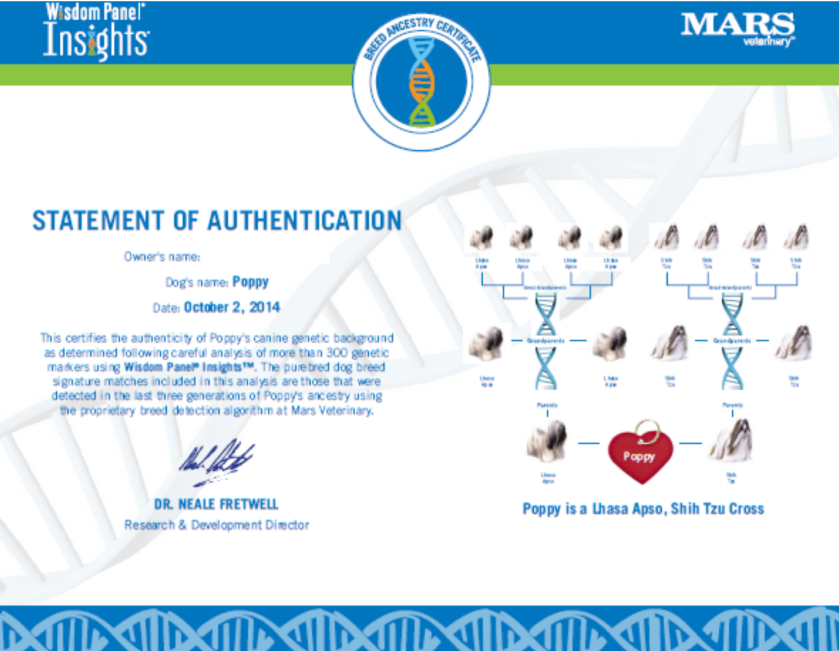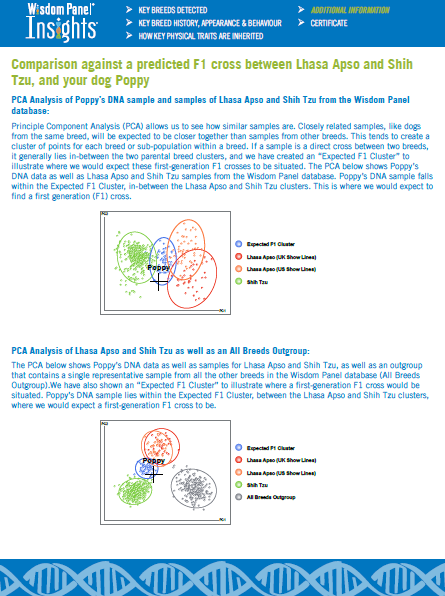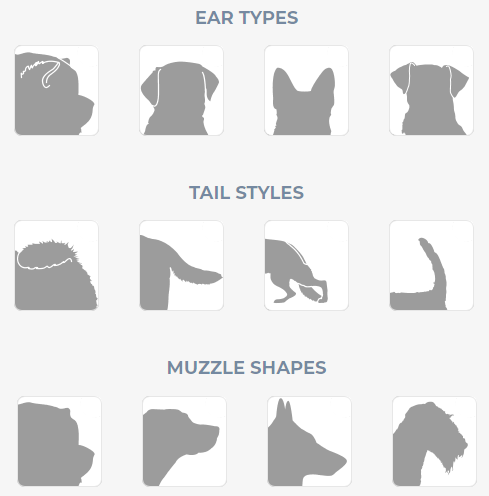Are You Curious About Your Dog’s DNA Background?
Do You Want To Find Out If Your Dog Is A True Pedigree Or Mixed Breed?
Need a Disease Detection Test?
Good News…You Can Quickly And Easily Find Out Exactly Which Breed(S) Make Up Your Dog’s DNA!
A Breed Detection DNA test shows you what breed(s) are a part of your dog’s DNA. It also includes Health Screening for disease detection.
Here is my dog Poppy, who I had DNA tested (the featured image above is also Poppy when she was a puppy):

I own both pedigree and mixed breed dogs. I see no difference, I love them all the same. From getting Poppy, my mixed breed dog (she was advertised as a hybrid ‘designer’ dog), I was curious to know if she was actually 50% Lhasa Apso 50% Shih Tzu, as the breeder had stated. Its hard to know exactly which breeds actually make up your dog’s DNA profile, and in many instances, most people have just had to take their breeders word for it.
I started to research how I could find out my answer and after lots of reading I came across the solution.
I purchased my kit, followed the instructions and sent off Poppy’s sample. It was so quick and easy. I was kept up to date on everything from when the sample had been received up until the final report.
Soon enough the results we in, I couldn’t wait to find out!
The results were:
Poppy is First Generation (F1) 50% Lhasa Apso 50% Shih Tzu!
Below I have included a copy of Poppy’s certificate:

In the report was Poppy’s key breeds detected & shown by percentage, her Family Tree, information on the key breed profiles in her DNA, key breed history, appearance, and behaviour, information on how key physical traits are inherited, her ideal weight, signed confirmation letter and certificate showing Statement of Authentication. Also included was the Principle Component Analysis (PCA) and Structure Analysis of Poppy’s DNA, which I found really interesting:


A good thing too, is no matter how long it has been since the DNA test, you can request an up to date copy of your dog’s certificate of authentication.
Why Get A DNA Breed Detection Test?
Genetic testing can help you to identify breeds and/or specific health issues that may be important to the health and happiness of your dog. You can work with your veterinarian and use your results to come up with a training, nutrition or even long-term healthcare plan. In addition to breed identification, your report will provide you with:
- Percentage breakdown of breeds and breed groups found in your dog
- A detailed family tree going back three generations
- Extensive information about each breed and breed group found
- A predicted weight profile
- Potentially life-saving drug sensitivity screening for MDR1
- The ability to share your results with your veterinarian
- A unique discount code to share with friends or family!
What’s more there is currently £10 off with promo code: Halloween2018
A mixed-breed dog’s heritage can vary in complexity from a simple first-generation cross of two breeds—say a Labrador and a Cocker Spaniel—to multiple breeds such as a Labrador, Cocker Spaniel, Rat Terrier and German Shepherd mix. Mixed-breed dogs can vary greatly in size, shape and colour and can be hard to identify visually. It can be difficult to identify all the breeds present in their genetic make-up just by looking at them. In fact, visual identification, even by professionals, is only accurate about 25% of the time!
In a dog physical appearance is largely controlled by a small number of genes – only about 2% – so it’s important to understand dominant vs recessive genes. Recessive are those you need two copies of to inherit the trait and dominant you only need one. Traits such as a short black coat, block head shape, or drop ears might make you think of some of the more popular breeds with these same features. But dominant traits such as these, just by the very nature of being dominant, can be attributed to literally hundreds of breeds beyond the one you’re thinking of. Likewise a trait that is recessive such as a long coat, prick ears, or tan points that is associated with a specific breed, may not make it past the dominant ones and therefore can’t be seen.
Looking around your own family you can probably see plenty of variation even among those most closely related to you such as your parents and/or siblings. It’s no different with dogs. Genetic Recombination is when chromosomes swap various pieces of DNA between them, resulting in the inheritance of a unique combination of DNA. This process happens in the passing down of genes from the parents, grandparents, and even great grandparents.
On average, through the DNA of their parents, puppies are receiving about 25% of their total genetic makeup from each of their grandparents and approximately 12.5% from the great grandparents. Because of the random nature in which genes are passed down, siblings can sometimes have differences in the breeds identified (or placement of the breeds) in their family trees. The puppies here are a great example as they are all from the same mother.
Mixed dogs can be simple or complex. The more pure or mixed breeds in a dog’s ancestry, the more difficult it is to identify a dog’s pedigree. The further back a given pedigree is in a dog’s history, the more mixed and diluted the characteristics in the genetic signature will be. Genetic signatures from purebred parents of a mixed-breed dog are easier to detect than grandparents, and both are much easier to detect than great-grandparents. A range of possible body shapes and sizes can be seen in the appearance of mixed-breed dogs. For example:

Three dogs can all have at least 50% Golden Retriever in their ancestry; however, they can all look very different, and none of them look like a purebred Golden. Depending on what dominant traits and/or recessive traits a dog receives from its parents, the way it expresses the different breeds in its ancestry can vary greatly.
They also test to see if there is any Wolf DNA in your dog’s genetic profile!
How Does It Work?
Doing a Breed Detection DNA test on your dog is so quick and easy to do, and best of all it is affordable. All that it involves is:
- Purchase your kit
- Swab your dog’s cheek to collect DNA.
- Activate your kit online.
- Mail in the test. Shipping is free!
- Receive results in approximately 2-3 weeks. Done!
How To Get Your DNA Kit
All you have to do is click here to purchase your DNA kit
(The Cheapest Online)
Don’t forget to enter your £10 off Promo Code at the check out!
Step-By-Step Of The Process
- Activate your kit and send off the sample
- You will receive an email to confirm the sample has been received
- You will receive another email once the sample is being processed
- You will be notified once the data is being analyzed
- You will find out your results and be sent the report (including DNA results certificate)
Sample Being Processed
Extracting DNA
The DNA from your dog’s cheek cells is removed and cleaned. This gives the lab pure DNA, which they can make more of and then analyse.
Genotyping Preparation
Your dog’s DNA is prepared for placement onto a special laboratory chip. First, it goes through fragmentation (breaking up into smaller parts). Then comes precipitation and suspension (preparing the DNA in the right concentration). Finally, hybridisation, where it’s placed on the chip for analysis.
Genotyping
Your dog’s DNA is genotyped onto a special laboratory chip. This involves extension and staining (where the sample undergoes base extension using an enzymatic process and fluorescent staining for visibility). Then comes imaging, where the DNA on the chip is “imaged” using a sophisticated scanning system. Finally, it goes through our advanced software performs the analysis and the final genotyping, producing electronic DNA, or eDNA.
Data Being Analysed
Processing Data
Your dog’s e-DNA is run through the lab’s sophisticated breed detection algorithm. Then your dog’s unique genetic profile is compared with more than 17 million different family trees created from the breed signatures in the labs extensive database to find the best match. This is also the stage where, depending on the test type, your dog’s DNA is sent through the advanced disease-detection process, and a “clear”, “carrier”, or “at-risk” status is determined.
What Is Included In The Results Report?
In approximately two to three weeks from the time your sample reaches the lab, you will be provided with a customised report with the genetic analysis of your dog’s ancestry, predicted weight, and health conditions:
Ancestry Features
Ancestry Percentages
You will be provides with an easy-to-understand breed percentage pie chart outlining the breeds or breed groups found in your dog’s ancestry.
Ancestry Tree
Wisdom Panel’s algorithm will analyse your dog’s DNA profile and compare it with signatures from their database of over 15,000 purebred samples. Each of the millions of possible family tree combinations will be given a score based on how well they match your dog’s profile. Your report will feature the tree with the best overall score.
Report Ready
Report Generation
Your dog’s unique report is prepared using the results from the labs algorithm and disease detection process, before providing you with your dog’s final results.
Health Screening
Wisdom Panel tests also screen for changes in the DNA associated with disease, commonly known as disease mutations. These can range from one or two potentially life-saving screens, to more than 150 in the Wisdom Panel Health test. For these mutation checks, the lab analyses determine whether your dog is a “carrier”, “at risk” or “clear” of a disease – offering an easy-to-understand explanation for each and what the results mean for your dog.
Multi-drug Resistance 1 (MDR1) is a genetic mutation found in many of the herding breeds, some sighthound breeds, and many mixed breed dogs. The MDR1 gene is responsible for production of a protein called P-glycoprotein. The P-glycoprotein molecule is a drug transport pump that plays an important role in limiting drug absorption and distribution (particularly to the brain) and enhancing the excretion/elimination of many drugs used in dogs.
Some dogs, particularly herding breeds or mixed-breed dogs with herding breed ancestry, have a mutation in the MDR1 gene that makes them defective in their ability to limit the absorption and distribution of many drugs. These dogs are also slower to eliminate drugs from the body that are transported by P-glycoprotein. As a result, dogs with the MDR1-mutation may have severe adverse reactions to some common drugs, so it is important to test your dog and share your results with your veterinarian so they can provide your dog with for the best possible care.
Breeds Affected by the MDR1 Mutation (frequency %):
- Australian Shepherd 50%
- Australian Shepherd, Mini 50%
- Border Collie < 5%
- Collie 70%
- English Shepherd 15%
- German Shepherd 10%
- Herding Breed Cross 10%
- Long-haired Whippet 65%
- McNab 30%
- Mixed Breed 5%
- Old English Sheepdog 5%
- Shetland Sheepdog 15%
- Silken Windhound 30%
Breeds Detected
Wisdom Panel has the largest breed database on the market with more than 220 breeds, types and varieties represented in 15,000 samples. Check out the full list of breeds at the end of the post so you can check it out for your breed of dog
They also test to see if there is any Wolf DNA in your dog’s genetic profile!
Foreign Breeds?
The WISDOM PANEL tests were developed using pure breeds primarily found on The Kennel Club and the American Kennel Club registry lists. If your dog was imported from a country other than the US, Canada, Western or Northern Europe, or you suspect that your dog’s ancestors are from outside these countries/areas, his breed ancestry may not be as well represented in the database.
During my research I read tons of stories from people who had had their dog’s genetic makeup tested believing their dog was a certain breed – only to find out the breed was not even in their dogs DNA profile!
What will your dog’s genetic profile DNA test show?
Unfold the Secrets of Your Dog’s DNA
–
Click here to begin finding out more about your dog’s genetic DNA profile
(The Cheapest Online)
–
List of Breeds Detected:
- Bouvier Des Flandres
- Border Terrier
- Border Collie
- Bolognese
- Bluetick Coonhound
- Bloodhound
- Black Russian Terrier
- Bichon Frise
- Biewer Terrier
- Berger Picard
- Bernese Mountain Dog
- Belgian Tervuren
- Beauceron
- Bergamasco
- Belgian Malinois
- Bearded Collie
- Bedlington Terrier
- Basset Hound
- Beagle
- Basenji
- Belgian Sheepdog
- Australian Terrier
- Barbet
- Australian Shepherd
- Azawakh
- Argentine Dogo
- Australian Cattle Dog
- Australian Kelpie
- American Water Spaniel
- American Staffordshire Terrier
- American Foxhound
- Alaskan Klee Kai
- American Eskimo Dog
- Alaskan Malamute
- Anatolian Shepherd Dog
- Afghan Hound
- Affenpinscher
- Airedale Terrier
- Akita
- Australian Koolie
- Black And Tan Coonhound
- Bullmastiff
- Bulldog
- Briard
- Bull Terrier
- Brussels Griffon
- Boykin Spaniel
- Brittany
- Boxer
- Borzoi
- Boston Terrier
- Dutch Shepherd Dog
- Dogue De Bordeaux
- Doberman Pinscher
- Dandie Dinmont Terrier
- Dalmatian
- Dachshund
- Curly-Coated Retriever
- Collie
- Cocker Spaniel
- Coton De Tulear
- Cirneco Dell’etna
- Chinook
- Chow Chow
- Chinese Shar-Pei
- Chihuahua
- Cesky Terrier
- Chesapeake Bay Retriever
- Chinese Crested
- Clumber Spaniel
- Cardigan Welsh Corgi
- Cavalier King Charles Spaniel
- Cane Corso
- Canaan Dog
- Canadian Eskimo Dog
- Cairn Terrier
- Grand Basset Griffon Vendéen
- French Bulldog
- Giant Schnauzer
- Hovawart
- Havanese
- Harrier
- Great Pyrenees
- Greyhound
- Gordon Setter
- Greater Swiss Mountain Dog
- Golden Retriever
- German Spitz
- Glen Of Imaal Terrier
- German Shepherd Dog
- German Shorthaired Pointer
- German Pinscher
- German Wirehaired Pointer
- Great Dane
- Flat-Coated Retriever
- Finnish Lapphund
- Finnish Spitz
- Field Spaniel
- Entlebucher Mountain Dog
- English Toy Spaniel
- English Springer Spaniel
- English Setter
- English Cocker Spaniel
- English Foxhound
- Large Münsterlander
- Lhasa Apso
- Leonberger
- Labrador Retriever
- Lakeland Terrier
- Lancashire Heeler
- Kritikos Lagonikos
- Löwchen
- Lagotto Romagnolo
- Jindo
- Kooikerhondje
- Komondor
- Kerry Blue Terrier
- Keeshond
- Japanese Chin
- Japanese Spitz
- Italian Greyhound
- Irish Water Spaniel
- Irish Setter
- Irish Red And White Setter
- Irish Wolfhound
- Ibizan Hound
- Icelandic Sheepdog
- Irish Terrier
- Kuvasz
- Perro De Presa Canario
- Petit Basset Griffon Vendeen
- Miniature Schnauzer
- Pyrenean Shepherd
- Pumi
- Portuguese Water Dog
- Pug
- Portuguese Podengo Pequeno
- Portuguese Podengo Medio
- Polish Greyhound
- Pomeranian
- Polish Lowland Sheepdog
- Podenco Canario
- Pointer
- Pharaoh Hound
- Puli
- Parson Russell Terrier
- Pembroke Welsh Corgi
- Papillon
- Otterhound
- Pekingese
- Old English Sheepdog
- Norwich Terrier
- Nova Scotia Duck Tolling Retriever
- Norwegian Buhund
- Norwegian Lundehund
- Norfolk Terrier
- Newfoundland
- Neapolitan Mastiff
- Mudi
- Mi-Ki
- Miniature Pinscher
- Norwegian Elkhound
- Mastiff
- Manchester Terrier
- Magyar Agar
- Miniature American Shepherd
- Maltese
- Maremma Sheepdog
- Miniature Bull Terrier
- Treeing Walker Coonhound
- Tibetan Terrier
- Tibetan Mastiff
- Taigan
- Tibetan Spaniel
- Sussex Spaniel
- Spanish Water Dog
- Swedish Vallhund
- Staffordshire Bull Terrier
- Spanish Greyhound
- Soft Coated Wheaten Terrier
- Skye Terrier
- Sloughi
- Siberian Husky
- Shih Tzu
- Shetland Sheepdog
- Scottish Terrier
- Scottish Deerhound
- Sealyham Terrier
- Samoyed
- Saint Bernard
- Schipperke
- Saluki
- Standard Schnauzer
- Russian Tsvetnaya Bolonka
- Silky Terrier
- Rottweiler
- Russell Terrier
- Rhodesian Ridgeback
- Standard Poodle
- Small Münsterlander
- Shiba Inu
- Spinone Italiano
- Toy Fox Terrier
- Smooth Fox Terrier
- Yorkshire Terrier
- White Swiss Shepherd
- Whippet
- West Highland White Terrier
- Welsh Terrier
- Welsh Springer Spaniel
- Weimaraner
- Wirehaired Vizsla
- Vizsla
- Wirehaired Pointing Griffon
- Wire Fox Terrier

